Working from home has been a blessing for me. However, most of the time, it results in extreme fatigue.
Hours and hours of attending work calls and spending time in front of the screen make me tired and restless.
So, how do you think we can Beat work-from-home fatigue?
Changing the work schedule and space, avoiding work on weekends, and socializing with people also help reduce work fatigue.
I have tried these techniques since I began working from home during the pandemic.
In this article, you can find some effective methods that you may consider to beat work-from-home fatigue.
Table of Contents Show
Does Working from Home Increases Fatigue?
Working from home completely differs from working in an office.
It can be a completely new experience for most workers. At the same time, it is challenging to shift to a small designated space from running errands through numerous cubicles.
You have to deal with multiple distractions while working from home. You may start munching some snacks during your work meetings or lie on your bed.
At the same time, if you love working in teams, it becomes complicated to work from home. You may start losing the motivation to work and miss your colleagues.
Since your network and connections will be limited, you may feel exhausted to work.
In addition, your work-from-home environment may not energize you to work.
Therefore, there are higher chances of increment in fatigue due to working from home.
Do you feel lazy while working from home? Take a look at our article on how to avoid being lazy when working from home.
Do you Have Work from Home Fatigue?
Do you feel too tired and restless after a few hours of work? If yes, this can be a symptom of work-from-home fatigue.
It often leads to demotivation or burnout within a short period at work.
We often mistake fatigue for just another day of feeling weary due to the many tasks we perform each day.
However, it can result in severe issues like detesting your entire work life.
So, how can we figure out if we have work-from-home fatigue? Here are some of the symptoms you can look for.
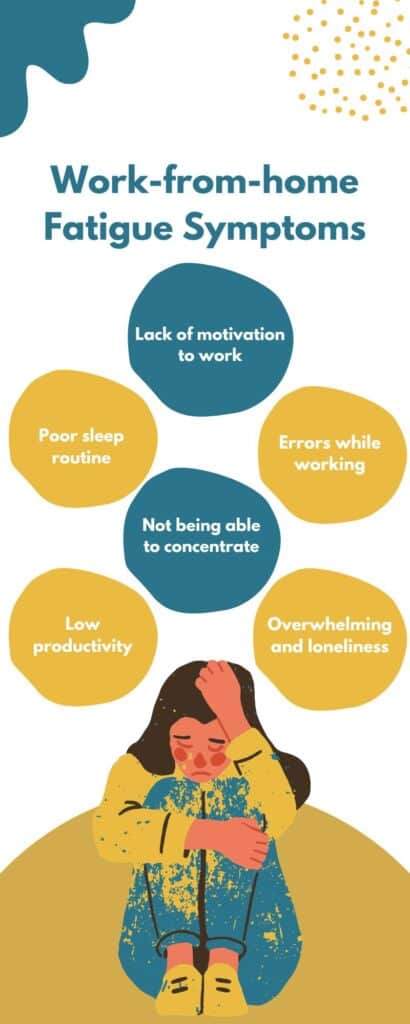
1. Low Motivation to Work
If you are losing your motivation to work, this could be a sign of work-from-home fatigue.
A little demotivation after long hours of work is nothing more than usual.
Low motivation distracts you from the desired goals, achievements, ambitions, and willingness to perform the tasks.
Similarly, low motivation can completely drift you apart from your day-to-day job-related activities if not given proper attention on time.
2. Poor Sleep Routine
If you are experiencing changes in your sleep routine, this might be another symptom of work-from-home fatigue.
People with work fatigue often struggle to sleep at the right time or wake up early in the morning.
You may start dozing off at your work desk due to a poorer sleep routine.

Some workers also wake up amidst their sleep too frequently for any reason. You must be conscious of your sleep schedule if you sleep for less than six hours.
Many professionals develop specific metabolic syndromes due to unhealthy sleep patterns and routines.
According to Harvard Business Review, sleep disturbances increase the risk of cancer, depression, and heart problems and decrease the level of productivity.
3. Not Being Able to Concentrate
Are you impulsive while you sit to work? Do you have the sudden urge to get out of your workspace and leave the task you have been doing?
This is because you cannot concentrate on the job, which is one of the significant symptoms of work-from-home fatigue.
Attention and concentration are significant factors when it comes to any performance.
Not being able to concentrate with mind and body leads to problems such as incomplete tasks and significant delays in submission.
As a result, it becomes difficult for you to achieve your smallest of goals.
4. Errors While Working
You may undergo more errors than usual while working due to work-from-home fatigue. This is something I have been through while working from home.
While working, minor mistakes are not a big deal and are unavoidable. However, making more errors can lead to complications in your task.
You might make more mistakes if you are not paying proper attention to what you are doing.
Research says, cognitive overload and other behavioral and moral problems have the tendency to cause errors and accidents.
Some mistakes ruin your entire task and expose you to certain risk factors related to your job. Therefore, it is essential to take the issue on a solid note.
5. Low Productivity
Work-from-home fatigue also has a harsh effect on the productivity level of a team member.
Once you feel exhausted, you feel like quitting the task you have been doing.
As a result, it becomes difficult for you to be more productive. Employees with fatigue and weariness gradually experience steadiness in their work completion.
Low Productivity will prevent you from utilizing and showcasing your skills through your submissions.
It will have a harmful effect not only on your performance but also on the performance of your Company.
Furthermore, it also tends to ravage your relationship with your administrator or subordinates.
15 Effective Ways to Beat Work-From-Home Fatigue in 2025
Are you constantly dealing with work-from-home fatigue?
Here are some practical ways you can consider if you want to beat the work-from-home fatigue in 2025.
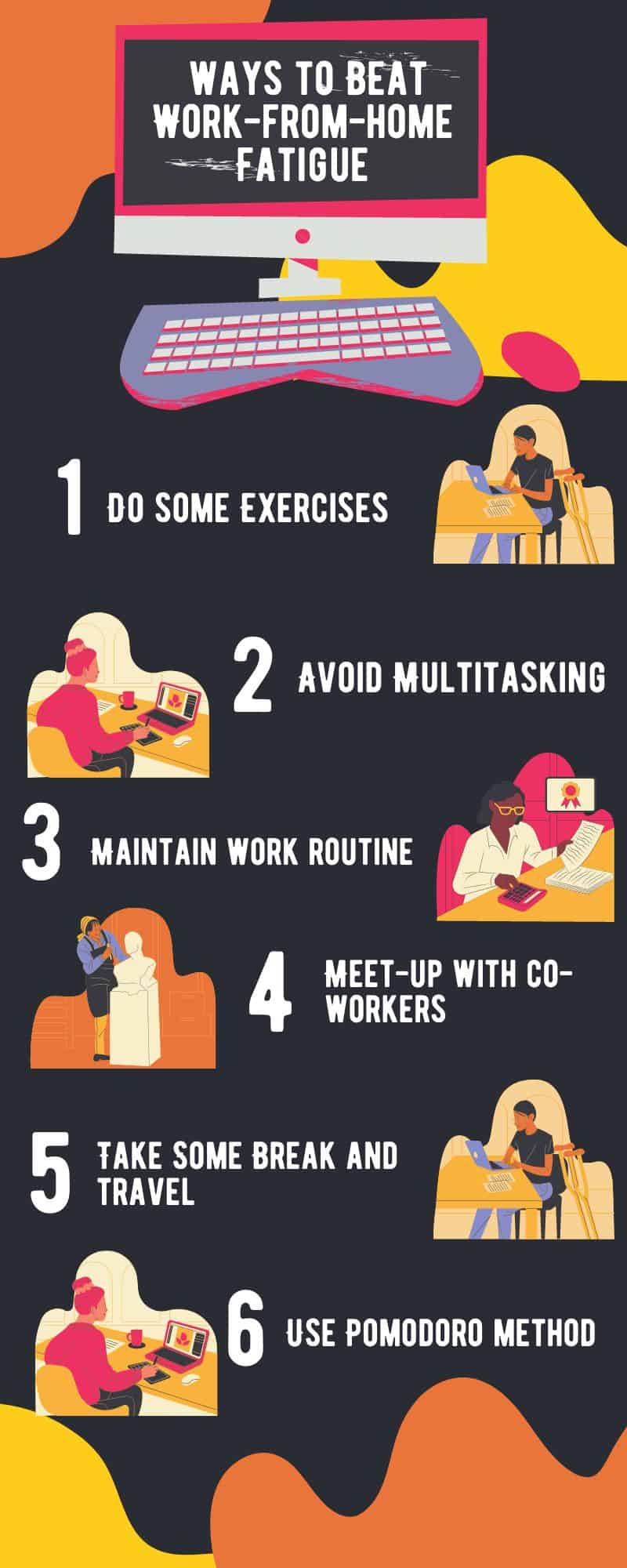
1. Explore the Root Cause
If you are dealing with work-from-home fatigue, exploring the root cause is the first and foremost thing to do.
Reasons behind fatigue usually vary from person to person.
Sometimes, it can be due to work overload, and at other times to isolation, monotonous routine, and lack of privacy or personal space while working.
First of all, figure out what is bothering you. And only after that begin exploring specific solutions.
If one does not work for you, you can try another.
You can try changing your work position and workspace, take a little break or spend time with your friends and family to get out of the fatigue zone you are shoved into.
2. Avoid Multitasking
While Multitasking may sound extraordinary to most people, it is not usually recommended.
Doing multiple things simultaneously makes you stress more, hurting your mental and physical well-being.
When you multitask, your attention is divided among several tasks, which makes it difficult to focus and causes memory loss.
When we force our brains to deal with multiple tasks simultaneously, it becomes challenging to be mindful of all the tasks we perform.
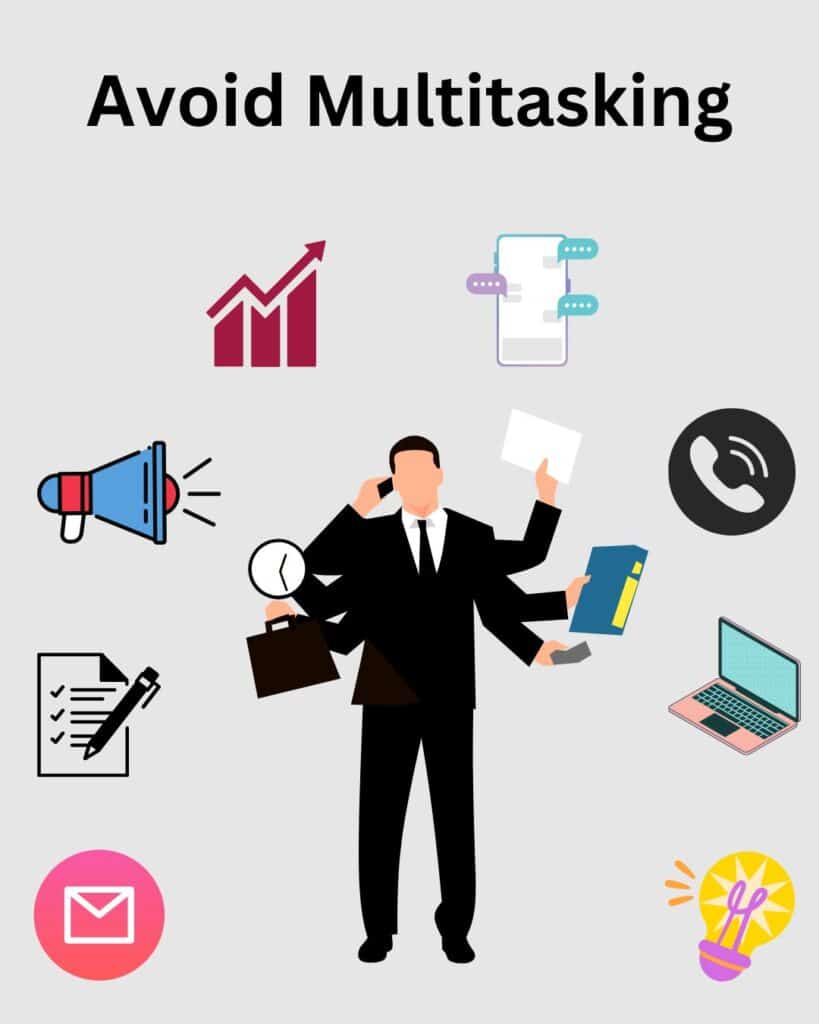
Not being able to cope with mindfulness may, later on, result in fatigue, anxiety, and stress.
3. Take Out Some Time for Exercise
Sometimes, fatigue arises due to a lack of mobility and physical activities. While working from home, most of us want to be in our comfortable spaces.
Some of us may even lie down or stay cozy in bed while working from home.
Spending hours without moving from one place tends to result in restlessness, tiredness, and fatigue.
Therefore, always take out some of your time for physical activity. Adding a few minutes of movement will make you more energetic and active.
You can make some stretching moves or go for a brisk walk outside. Some yoga poses or a short cardio routine also sounds better.

According to research, gym yoga appears to be effective for stress amelioration and promotion of psychological health among workers experiencing stress.
You can do some stretches like Forward Fold stretch, Seated Back Twists, or Bound Angle Pose in your break time to prevent stiffness.
4. Find a Comfortable Place to Work
While we work from home, we can select our working spaces. It gives us a positive feeling towards work life.
Exploring different workspaces within your home will help you select the most comfortable area for work purposes.
It can be anywhere from your room to even outdoors.
Also, ensure that your work desk is right-sized and your chair is ergonomic and comfortable. A little physical discomfort at work can harm your health.
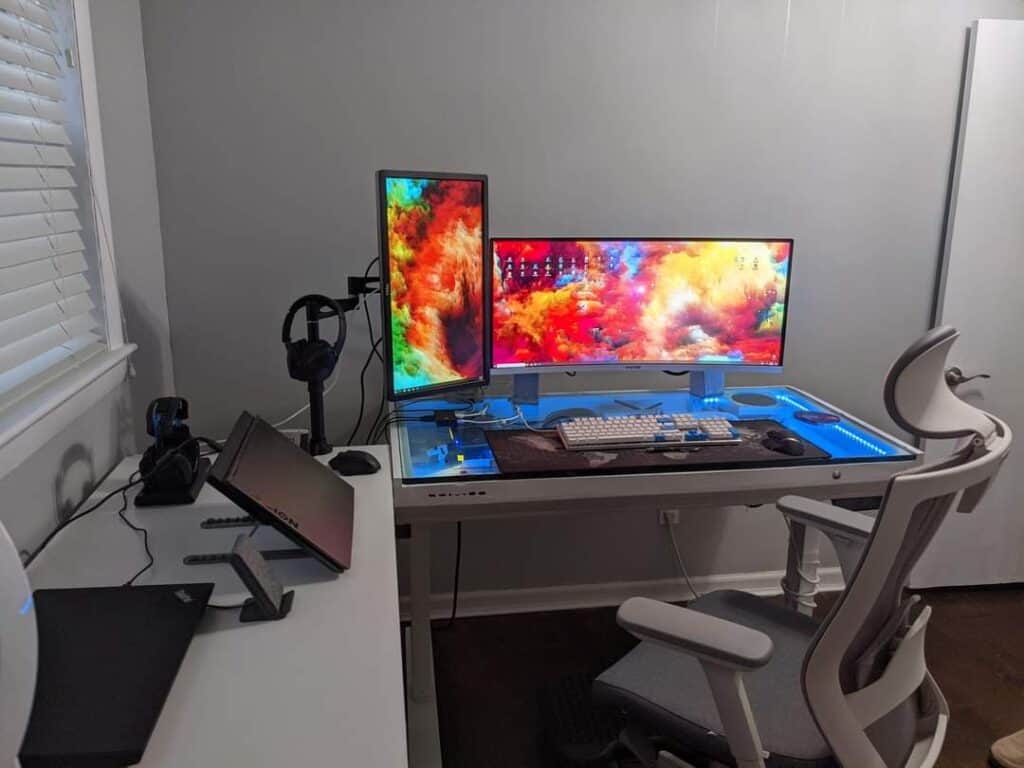
You can even work from the couch or while sitting on the floor. However, be sure to make it ergonomic and cozy.
Research conducted among the workers of Garment industries in Bangladesh has concluded that designing comfortable chairs and tables reduces their discomfort and fatigue to a great extent.
Once you are seated comfortably, you won’t experience fatigue or any kind of lethargy for an extended period.
Related article: How to work from home without a desk?
5. Maintain the Work Routine
A scheduled work routine always gives you fruitful results in the end.
Although maintaining a strict work routine is difficult, especially when working from home, you should consider making an effort.
I have faced the challenge of not being able to maintain my work routine, which later resulted in stress and a lot of fatigue.
You might face a similar issue, mainly if you are a freelancer.
Since you can choose your time, you end up working haphazardly. As a result, you won’t be able to sort out your tasks at a time.
Therefore, always make a work routine and do your job accordingly. You can select any time of the day you love to work and stick to it.
Here are some strategies for creating a strict work schedule:
- Set realistic goals.
- Make manageable sections of your work.
- Use a planner, sticky notes, or a diary to create a workflow and keep it visible.
- Sort your work according to priority, deadline, difficulty, etc.
- Create a to-do list using planning apps such as Tusk, Friday, Any.do, and Pagico.
6. Arrange a Meet Up With Your Work Mates
Make sure to meet your colleagues physically once in a while. Working from home prevents us from experiencing real-life talks with our workmates.
Arranging get-togethers guarantees a strong bond, fun times, and positive engagement with your friends.
At the same time, you will feel more inclined towards your job and energized to work.
Therefore, spend some time in a nearby cafe for a coffee break, arrange a lunch with your virtual team, or consider experiencing adventures together.
Activities like these will break your monotony from regular work and strengthen your relationship with your colleagues.
7. Engage Yourself in Different Team Events
Isolation has to do a lot with work-from-home fatigue. Getting used to remote jobs can be difficult, especially for those who have always worked on-site.
In such situations, team events can become a great savior. Ensure to engage yourself in different team-building events and programs.
You will get a chance to interact actively with your colleagues and enhance your skills.
Team events always contribute to fostering the relationship between the members of any organization.
In addition, you will also get a chance to experience something different from their regular work-life routine.
Popular team-building activities include Online Office Games, Virtual Team Building Bingo, Blackout Truth or Dare, and Typing Speed Race.
8. Avoid Working on Weekends
If you are a workaholic and work on weekends, you must stop doing that. Although you find it satisfying for yourself, you may start hating the thing eventually.
After a week-long of numerous tasks and meeting deadlines, you deserve a break to do something different.
Therefore, make sure to do something that breaks the monotony of your regular day-to-day routine.
Our mind and body require a whole day of rest after functioning strongly to complete all clerical engagements.
Working for an entire week will result in health complications relating to fatigue.
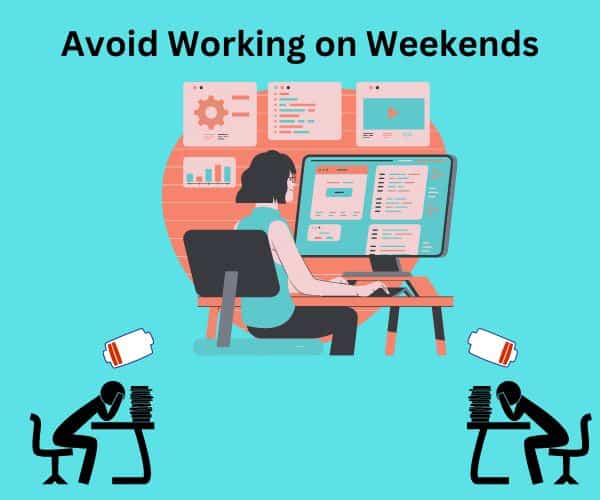
Therefore, the purpose of the weekend is for self-renewal, refueling, and renewal as we prepare for the coming week’s challenges.
Stop working on weekends just for the sake of some extra income or to submit the job beforehand.
During weekends, spend time with your family, watch a movie or theatre or meet with your friends.
9. Find a New Place to Work
You can sometimes find a new place to work to avoid work-from-home fatigue.
Working in the same environment can be monotonous and give a lethargic feeling.
However, changing the workplace for a while will rejuvenate and activate your mind.
You can visit a nearby cafe, a resort, or a park for a day or two just to get a new remote work experience.
A few of my friends introduce themselves as digital nomads since they keep switching their working environments now and then.
Traveling longer distances or driving faraway places is not essential to swap the workplace. You can explore areas that are near to you and are easily accessible.
10. Reduce Your Daily Meetings
It is imperative to figure out your to-do lists chronologically. Some people have the habit of doing everything in a gulp.
It is not necessary that you have to do every bit of your work in a single day.
Organizing or attending multiple meetings on the same day can be a very much tiring experience.
In addition, countless online interactions often lead to “Zoom Fatigue.”
Therefore, always ensure the most pressing task for you and set aside the time for its completion.
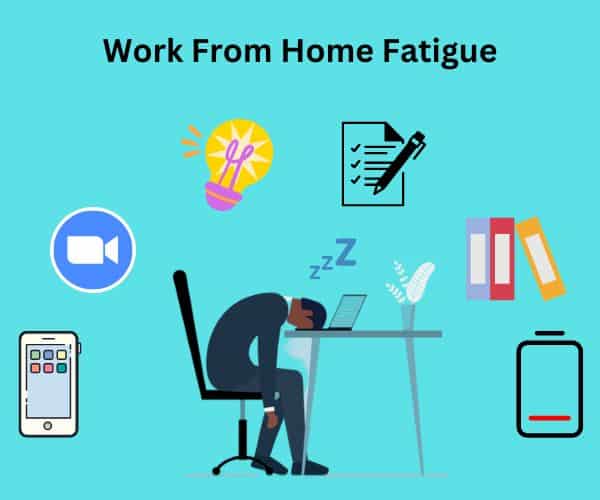
Instead of scheduling a meeting for every small and more significant task, you can use emails and other team communication apps to connect with your workmates.
Make sure you do not exceed three-to-four meetings on a single workday.
Holding too many sessions a day will create problems addressing the real agendas.
11. Differentiate the Everyday Task
Vary your day-to-day task to feel the difference in each workday. As a team member, you are susceptible to performing almost the exact nature of functions.
However, differentiating the everyday job will ensure you do not get bored or tired while sitting at work.
If you have a bunch of tasks to complete, try different nature tasks every alternate day.
It will kill your fatigue and allow you to seek new ideas and inventions and do more research.
For instance, if you have worked on maintaining the file records of the Company for one entire day, switch to some other tasks like taking care of the correspondence the next day.
12. Use of the Pomodoro Method
Pomodoro Method is a time management method used by people to ensure better Productivity.
It refers to a 25-minute focused session of work separated by five minutes break.
Using this method will allow you to stay focused on your task because you already know that you have built-in leaves that lie ahead.
Here is how you can practice the Pomodoro Method:
- Select any task that you are going to accomplish
- Set timer to 25 minutes
- Do your homework until the timer rings
- Now, take a break for five minutes
- Work for the next 25 minutes
- You can preferably take longer breaks after 2-3 work periods.
Check out some popular Pomodoro techniques below;
| Pomodoro based Apps | Features |
|---|---|
| Glan | Create a to-do list and complete Pomodoro sessions with chosen break timings |
| FocusList | Pomodoro timer with stats to see a calendar view of your past activities. |
| Be Focused | Pomodoro timer with customization options: task management, the ability to set break and work session durations, goal tracking, pie chart reporting, and 3D touch |
| Clockwork Tomato | Customize timers, sounds, colors, style, and behavior with more than 50 options |
13. Be in Touch with Non-Work Friends
Do not forget to be in touch with your non-work friends when you get too busy.
Make sure that you won’t dive too deep into your professional life.
Generally, we have a formal relationship with our work friends. Therefore, it is challenging to have light and fun conversations with them.
Since most of the talks are related to work and stuff, we cannot open up with them to a great extent. Therefore, it is essential to be in touch with non-work friends.
Connecting with non-work friends beyond the office helps deal with your anxiety and stress related to work life.
14. Take a Break and Travel
Sometimes, all you need to do is pack your bags and leave for a place you adore.
Working from home requires you to stay most of the time inwards.
As a result, your life becomes too monotonous and boring. If you feel like you are pushing yourself too much into work, take a break for a few days and set out for a journey.
You can also go for a solo trip somewhere not too far away and still beautiful.
It will allow you to explore yourself; a little more, and you can have plenty of ‘me time.”

Otherwise, you can also plan a short trip with your friends or family. Traveling to places will permanently relieve your stress and boost the level of your happiness.
After you return home from your trip, you can resume the task with the entire motivation.
Read more: How to work remotely while travelling?
15. Explore your Hobbies
While you dive into the professional world, do not forget to relive the moments by exploring your long-lost hobbies.
It is supposed to be one of the healthiest ways of beating work-from-home fatigue.
Spending time doing things you love makes you feel good and helps you remain productive.
Therefore, if you ever get lethargic and exhausted from your white-collar job, take some time to play with your hobbies.
You can either practice gardening, read a book, paint anything you love, or do your skincare routine.
Anything you love that takes you out of the monotony of work-life can be practiced.
Final Verdict
Working from home comes along with tons of advantages.
However, for social butterflies who love working with their colleagues, it can be challenging to get used to the new routine.
If you ever experience work-from-home fatigue, you can always try the techniques mentioned above to activate yourself.
Since working from home is a completely different experience than working in an office, having work-from-home fatigue is alright.
However, if you feel like you are facing many challenges coping with them, you can always ask for help.
Read more: 10 Effective Tips to Create a Professional Home Office


